Spatial Pattern of Air Pollutant Concentrations and Their Relationship with Meteorological Parameters in Coastal Slum Settlements of Lagos, Southwestern Nigeria
Abstract
:1. Introduction
2. Materials and Methods
2.1. Study Area and Sample Site
2.1.1. Ijora-Badia
2.1.2. Iwaya
2.1.3. Majidun
2.1.4. Oworoshoki
2.1.5. Bariga
2.2. Measurement and Sampling of Pollutants
2.3. Air Pollutant Data and Quality Assurance
2.4. Assessment of Spatiotemporal Variations of Air Pollutants
2.5. Statistical Analysis
3. Results
3.1. Seasonal Variation in Air Pollutants
3.2. Temporal Variations in Air Pollutant Concentrations in the Slum Settlements
3.3. Relationship between Air Quality and Meteorological Parameters
3.4. Influence of Meteorological Parameters on Air Pollutants
3.5. Spatial Distribution of Air Pollutants across Coastal Slum Settlements
4. Discussion
5. Conclusions
Author Contributions
Funding
Institutional Review Board Statement
Informed Consent Statement
Data Availability Statement
Acknowledgments
Conflicts of Interest
References
- Borck, R.; Schrauth, P. Population density and urban air quality. Reg. Sci. Urban Econ. 2021, 86, 103596. [Google Scholar] [CrossRef]
- Landrigan, P.J. Air pollution and health. Lancet Public Health 2017, 2, e4–e5. [Google Scholar] [CrossRef] [Green Version]
- Phoungthong, K.; Tekasakul, S.; Tekasakul, P.; Prateepchaikul, G.; Jindapetch, N.; Furuuchi, M.; Hata, M. Emissions of particulate matter and associated polycyclic aromatic hydrocarbons from agricultural diesel engine fueled with degummed, deacidified mixed crude palm oil blends. J. Environ. Sci. 2013, 25, 751–757. [Google Scholar] [CrossRef]
- Phoungthong, K.; Tekasakul, S.; Tekasakul, P.; Furuuchi, M. Comparison of particulate matter and polycyclic aromatic hydrocarbons in emissions from IDI-turbo diesel engine fueled by palm oil–diesel blends during long-term usage. Atmos. Pollut. Res. 2017, 8, 344–350. [Google Scholar] [CrossRef]
- Godehart, S.; Vaughan, A. Research Reviewing the Bng in Relation to Upgrading Informal Settlements. In Research Paper for Theme 1: Conceptual Framework; The National Department of Housing, Singapore Institute of Management (SIM): Singapore, 2008; p. 20. [Google Scholar]
- FGN-MDG Report. The Millennium Development Goals Report: We Can End Poverty; United Nations: New York, NY, USA, 2010; Available online: http://www.mdgreport.org (accessed on 15 January 2010).
- Agbola, T.; Agunbiade, E.M. Urbanization, slum development and security of tenure: The challenges of meeting millennium development goal 7 in metropolitan Lagos, Nigeria. In Urban Population-Environment Dynamics in the Developing World: Case Studies and Lessons Learned; Committee for International Cooperation in National Research in Demography (CICRED): Paris, France, 2009; pp. 77–106. Available online: http://www.populationenvironmentresearch.org/workshops.jsp#W2007 (accessed on 21 October 2019).
- George, C.K. The Challenges of Urbanization in Nigeria Urban Centres: A Review of the Physical Planning Development of Lagos Megalopolis. In Proceedings of Architects Colloquium; Architects Registration Council of Nigeria: Abuja, Nigeria, 2008; pp. 74–95. [Google Scholar]
- Falade, J.B. The Role of Physical Planning in a Megacity. In Paper Presented on the Theme: Towards a Harmonius Megacity Organized by the Lagos State Government during the 2008 World Habitat Day at the Lagos State Secretariat, Ikeja; Federal Ministry of Power, Works and Housing: Abuja, Nigeria, 2008; pp. 1–12. [Google Scholar]
- UN-Habitat; (United Nations Human Settlements Programme). State of the World’s Cities 2010/2011-Cities for All: Bridging the Urban Divide; Earthscan Publishers: Nairobi, Kenya, 2008; Available online: www.unhabitat.org (accessed on 10 March 2018).
- Ojiodu, C.C.; Okuo, J.M.; Olumayede, E.G. Spatial and temporal variability of volatile organic compounds (VOCs) pollution in Appa industrial areas of Lagos state, Southwestern-Nigeria. J. Acad. Environ. Sci. 2013, 1, 53–61. [Google Scholar]
- Do, D.H.; Van Langenhove, H.; Walgraeve, C.; Hayleeyesus, S.F.; De Wispelaere, P.; Dewulf, J.; Demeestere, K. Volatile organic compounds in an urban environment: A comparison among Belgium, Vietnam and Ethiopia. Int. J. Environ. Anal. Chem. 2013, 93, 298–314. [Google Scholar] [CrossRef]
- Olowoporoku, A.; Longhurst, J.; Barnes, J. Framing Air Pollution as a Major Health Risk in Lagos, Nigeria. In Air Pollution XX; Brebbia, C., Longhurst, J., Eds.; WIT Press: Southampton, UK; Boston, MA, USA, 2012; pp. 479–486. ISBN 9781845645823. [Google Scholar]
- Kumar, P.; Yadav, S. Seasonal variations in water soluble inorganic ions, OC and EC in PM10 and PM>10 aerosols over Delhi: Influence of sources and meteorological factors. Aerosol Air Qual. Res. 2016, 16, 1165–1178. [Google Scholar] [CrossRef] [Green Version]
- Suvarapu, L.N.; Seo, Y.K.; Baekm, S.O. Volatile organic compounds and polycyclic aromatic hydrocarbons in ambient air of Indian cities—A review. Res. J. Chem. Environ. 2013, 17, 67–75. [Google Scholar]
- Luken, R.A.; Van Berkel, R.; Leuenberger, H.; Schwager, P. A 20-year retrospective of the national cleaner production centres programme. J. Clean. Prod. 2016, 112, 1165–1174. [Google Scholar] [CrossRef]
- Wang, P.; Cao, J.; Tie, X.; Wang, G.; Li, G.; Hu, T.; Wu, Y.; Xu, Y.; Xu, G.; Zhao, Y.; et al. Impact of Meteorological Parameters and Gaseous Pollutants on PM2.5 and PM10 Mass Concentrations during 2010 in Xi’an, China. Aerosol Air Qual. Res. 2015, 15, 1844–1854. [Google Scholar] [CrossRef] [Green Version]
- Zhou, H.; Yu, Y.; Gu, X.; Wu, Y.; Wang, M.; Yue, H.; Gao, J.; Lei, R.; Ge, X. Characteristics of Air Pollution and Their Relationship with Meteorological Parameters: Northern Versus Southern Cities of China. Atmosphere 2020, 11, 253. [Google Scholar] [CrossRef] [Green Version]
- Wang, X.-C.; Klemeš, J.J.; Dong, X.; Fan, W.; Xu, Z.; Wang, Y.; Varbanov, P.; Reviews, S.E. Air pollution terrain nexus: A review considering energy generation and consumption. Renew. Sust. Energ. Rev. 2019, 105, 71–85. [Google Scholar] [CrossRef]
- Ma, Y.; He, W.; Zhao, H.; Zhao, J.; Wu, X.; Wu, W.; Li, X.; Yin, C. Influence of Low Impact Development practices on urban diuse pollutant transport process at catchment scale. J. Clean. Prod. 2019, 213, 357–364. [Google Scholar] [CrossRef]
- Zhong, Q.; Ma, J.; Shen, G.; Shen, H.; Zhu, X.; Yun, X.; Meng, W.; Cheng, H.; Liu, J.; Li, B.; et al. Distinguishing Emission-Associated Ambient Air PM2.5 Concentrations and Meteorological Factor-Induced Fluctuations. Environ. Sci. Technol. 2018, 52, 10416–10425. [Google Scholar] [CrossRef] [Green Version]
- Liu, X.; Nie, D.; Zhang, K.; Wang, Z.; Li, X.; Shi, Z.; Wang, Y.; Huang, L.; Chen, M.; Ge, X.; et al. Evaluation of particulate matter deposition in the human respiratory tract during winter in Nanjing using size and chemically resolved ambient measurements. Air Qual. Atmos. Health 2019, 12, 529–538. [Google Scholar] [CrossRef]
- Meng, C.; Cheng, T.; Gu, X.; Shi, S.; Wang, W.; Wu, Y.; Bao, F. Contribution of meteorological factors to particulate pollution during winters in Beijing. Sci. Total Environ. 2019, 656, 977–985. [Google Scholar] [CrossRef]
- He, J.; Gong, S.; Yu, Y.; Yu, L.; Wu, L.; Mao, H.; Song, C.; Zhao, S.; Liu, H.; Li, X.; et al. Air pollution characteristics and their relation to meteorological conditions during 2014–2015 in major Chinese cities. Environ. Pollut. 2017, 223, 484–496. [Google Scholar] [CrossRef] [PubMed]
- Chan, C.K.; Yao, X. Air Pollution in Mega Cities in China. Atmos. Environ. 2008, 42, 1–42. [Google Scholar] [CrossRef]
- Zhang, Q.; Tie, X.; Lin, W.L.; Cao, J.J.; Quan, J.N.; Ran, L.; Xu, W.Y. Measured Variability of SO2 in an Intensive Fog Event in the NCP Region, China; Evidence of High Solubility of SO2. Particuology 2013, 11, 41–47. [Google Scholar] [CrossRef]
- Cobourn, W.G. An enhanced PM2.5 air quality forecast model based on nonlinear regression and back-trajectory concentrations. Atmos. Environ. 2010, 44, 3015–3023. [Google Scholar] [CrossRef]
- Liu, Y.; He, K.; Li, S.; Wang, Z.; Christiani, D.C.; Koutrakis, P. A statistical model to evaluate the effectiveness of PM2.5 emissions control during the Beijing 2008 Olympic Games. Environ. Int. 2012, 44, 100–105. [Google Scholar] [CrossRef]
- Liang, X.; Zou, T.; Guo, B.; Li, S.; Zhang, H.; Zhang, S.; Huang, H.; Chen, S.X. Assessing Beijing’s PM2.5 pollutions: Severity, weather impact, APEC and winter heating. Proc. R. Soc. Lond. Ser. 2015, 471, 20150257. [Google Scholar] [CrossRef] [Green Version]
- Afrin, S.; Islam, M.; Ahmed, T. A Meteorology Based Particulate Matter Prediction Model for Megacity Dhaka. Aerosol Air Qual. Res. 2020, 21, 200371. [Google Scholar] [CrossRef]
- Badmos, O.S.; Rienow, A.; Callo-Concha, D.; Greve, K.; Jürgens, C. Urban Development in West Africa—Monitoring and Intensity Analysis of Slum Growth in Lagos: Linking Pattern and Process. Remote Sens. 2018, 10, 1044. [Google Scholar] [CrossRef] [Green Version]
- Adama, O. Slum upgrading in the era of World-Class city construction: The case of Lagos, Nigeria. Int. J. Urban Sustain. Dev. 2020, 12, 219–235. [Google Scholar] [CrossRef] [Green Version]
- Obaitor, O.S.; Lawanson, T.O.; Stellmes, M.; Lakes, T. Social Capital: Higher Resilience in Slums in the Lagos Metropolis. Sustainability 2021, 13, 3879. [Google Scholar] [CrossRef]
- Wang, J.; Maduako, I. Spatio-temporal urban growth dynamics of Lagos Metropolitan Region of Nigeria based on Hybrid methods for LULC modeling and prediction. Eur. J. Remote Sens. 2018, 51, 251–265. [Google Scholar] [CrossRef] [Green Version]
- Lagos-State/UNCHS. Identification of Urban Renewal Areas in Metropolitan Lagos; Lagos—State/UNCHS: Lagos, Nigeria, 1984. [Google Scholar]
- Afrin, S.; Islam, M.M.; Ahmed, T.; Ali, M.A. The influence of meteorology on particulate matter concentration in the air of Dhaka City. In Proceedings of the 2nd International Conference on Advances in Civil Engineering (ICACE-2014), Dubai, United Arab Emirates, 1–2 October 2014. [Google Scholar]
- Islam, M.M.; Afrin, S.; Ahmed, T.; Ali, M.A. Meteorological and seasonal influences in ambient air quality parameters of Dhaka city. J. Civ. Eng. 2015, 43, 67–77. [Google Scholar]
- Islam, N.; Saroar, M.G.; Ahmed, T. Meteorological influences on atmospheric particles in Darus Salam Area of Dhaka City. In Proceedings of the 4th International Conference on Civil Engineering for Sustainable Development (ICCESD), Khulna, Bangladesh, 9–11 February 2018; pp. 1–12. Available online: http://www.iccesd.com/proc_2018/Papers/r_p4167.pdf (accessed on 15 July 2020).
- Kayes, I.; Shahriar, S.A.; Hasan, K.; Akhter, M.; Kabir, M.M.; Salam, M.A. The relationships between meteorological parameters and air pollutants in an urban environment. Glob. J. Environ. Sci. Manag. 2019, 5, 265–278. [Google Scholar] [CrossRef]
- Biswas, S.K.; Tarafdar, S.A.; Islam, A.; Khaliquzzaman, M. Investigation of Sources of Atmospheric Particulate Matter (APM) at an Urban Area in Bangladesh; Chemistry Division, Atomic Energy Centre: Dhaka, Bengal, 2001. [Google Scholar]
- Guttikunda, S. Impact Analysis of Brick Kilns on the Air Quality in Dhaka, Bangladesh. SIM-Air Work. Pap. Ser. 2009, 21, 234. Available online: www.urbanemissions.info/simair (accessed on 3 August 2019).
- Begum, B.A.; Biswas, S.K.; Hopke, P.K.; Cohen, D.D. Multi-element analysis and characterization of atmospheric particulate pollution in Dhaka. Aerosol Air Qual. Res. 2006, 6, 334–359. [Google Scholar] [CrossRef]
- Boman, J.; Gatari, M.J.; Wagner, A.; Hossaini, M.I. Elemental characterization of aerosols in urban and rural locations in Bangladesh. X-Ray Spectrom. 2005, 34, 460–467. [Google Scholar] [CrossRef]
- World Population Review. Lagos Population. Available online: https://worldpopulationreview.com (accessed on 20 June 2021).
- Lagos Water Regulatory Commission (LSWRC). Introduction. 2016. Available online: http://lswrc.lagosstate.gov.ng/2016/06/10/introduction-2 (accessed on 16 March 2020).
- Oyegoke, S.O.; Sojobi, A.O. Developing appropriate technique to alleviate the Ogun River network annual flooding problems. Int. J. Sci. Eng. Res. 2012, 3, 1–7. [Google Scholar]
- George, C.K. Challenges of Lagos as a Mega-City. 2010. Available online: http://www.allafrica.com/stories/201002221420.html (accessed on 12 July 2010).
- UN. World Urbanization Prospects, Population Division. New York. 2018. Available online: https://population.un.org (accessed on 19 June 2021).
- United Nations Development Programme. What will it take to achieve the Millennium Development Goals-An International Assessment, Goran Holmquist, External Financing of Social Protection: Opportunities and Risks. Dev. Policy Rev. 1984, 30, 5–27. [Google Scholar]
- Morka, F.C. A Place to Live: A Case Study of the Ijora-Badia Community in Lagos, Nigeria. Enhancing Urban Safety and Security: Global Report on Human Settlements. 2007. Available online: https://staging.unhabitat.org/downloads/docs/GRHS.2007.CaseStudy.Tenure.Nigeria.pdf (accessed on 15 July 2017).
- Olulade, P. Assessing the Lagos Megacity Selected Slum Settlements Housing and Environmental Conditions. J. Multidiscip. Eng. Sci. Technol. 2016, 3, 5408–5416. [Google Scholar]
- Action Health Incorporated. A Promise to Keep: Supporting Out-of-School Adolescent Girls to Reach Their Potential; Action Health Incorporated and Lagos State Ministry of Education: Lagos, Nigeria, 2011. [Google Scholar]
- Kunnuji, M.O. Experience of domestic violence and acceptance of intimate partner violence among out-of-school adolescent girls in Iwaya Community, Lagos state. J. Interpers. Violence 2015, 30, 543–564. [Google Scholar] [CrossRef] [PubMed]
- Sahara Reporters. Lagos State Government Demolishes 200 Houses at Iwaya. 19 August 2017. Available online: https://secure.saharareporters.com/2017/08/19/lagos-stategovernment-demolishes-200-houses-iwaya (accessed on 2 April 2019).
- Dekolo, S.O.; Olayinka, D.N. Monitoring peri-urban land use change with multi-temporal Landsat imagery. In Urban and Regional Data Management: UDMS Annual; Ellul, C., Zlatanova, S., Rumor, M., Laurini, R., Eds.; CRS, Taylor & Francis: London, UK, 2013; pp. 145–159. [Google Scholar]
- NPC. National Population Commission: Population Data Sheet 1 and Summary of Sensitive Tables; National Population Commission: Abuja, Nigeria, 2006; Volume 5. [Google Scholar]
- Adeniyi, T.A.; Adeonipekun, P.A.; Olowokudejo, J.D.; Akande, I.S. Airborne Pollen Records of Shomolu Local Government Area in Lagos State. Not. Sci. Biol. 2014, 6, 428–432. [Google Scholar] [CrossRef] [Green Version]
- Oyinloye, M.; Olamiju, I.; Ogundiran, A. Environmental Impact of Flooding on Kosofe Local Government Area of Lagos State, Nigeria: A GIS Perspective. J. Environ. Earth Sci. 2013, 3, 57–66. [Google Scholar]
- Sajil Kumar, P.J.; Jegathambal, P.; James, E.J. Multivariate and Geostatistical Analysis of Groundwater Quality in Palar River Basin. Int. J. Geol. 2011, 5, 108–119. [Google Scholar]
- Odekanle, E.L.; Fakinle, B.S.; Jimoda, L.A.; Okedere, O.B.; Akeredolu, F.A.; Sonibare, J.A. In vehicle and pedestrian exposure to carbon monoxide and volatile organic compounds in a mega city. Urban Clim. 2017, 21, 173–182. [Google Scholar] [CrossRef]
- Payus, C.M.; Vasu Thevan, A.T.; Sentian, J. Impact of school traffic on outdoor carbon monoxide levels. City Environ. Interact. 2020, 4, 100032. [Google Scholar] [CrossRef]
- USEPA. Volatile Organic Compounds Impact on Indoor Air Quality. 2019. Available online: https://www.epa.gov/indoor-air-quality-iaq/volatile-organic-compouns (accessed on 11 April 2019).
- FEMEnv. National Emission Standards for Hazardous Air Pollutants for Source Categories. Portland Cements Manufacturing Industry. Federal Register. 1999. Available online: https://www.gpo.gov/fdsys/pkg (accessed on 14 June 2018).
- NAAQS. Criteria Air Pollutants Ambient Standards. 2012. Available online: https://epa.gov (accessed on 30 June 2021).
- World Health Organization. Air Quality Guidelines for Particulate Matter, Ozone, Nitrogen Dioxide and Sulfur Dioxide: Summary of Risk Assessment; World Health Organization: Geneva, Switzerland, 2006; Available online: https://apps.who.int/iris/handle/10665/69477. (accessed on 30 June 2021).
- Baller, R.D.; Richardson, K.K. Social integration, imitation, and the geographic patterning of suicide. Am. Soc. Rev. 2002, 67, 873–888. [Google Scholar] [CrossRef]
- Getis, A.; Ord, J.K. Local Spatial Statistics: An Overview; John Wiley and Sons: Hoboken, NJ, USA, 1996. [Google Scholar]
- Shin, S.; Moon, H.I.I.; Lee, K.S.; Hong, M.K.; Byeon, S.H. A chemical risk ranking and scoring method for the selection of harmful substances to be specially controlled in occupational environments. Int. J. Environ. Res. Public Health 2014, 11, 12001–12014. [Google Scholar] [CrossRef] [PubMed] [Green Version]
- Taghvaee, S.; Sowlat, M.H.; Mousavi, A.; Hassanvand, M.S.; Yunesian, M.; Naddafi, K.; Sioutas, C. Source apportionment of ambient PM 2.5 in two locations in central Tehran using the Positive Matrix Factorization (PMF) model. Sci. Total Environ. 2018, 628, 672–686. [Google Scholar] [CrossRef] [PubMed]
- Guerreiro, C.B.; Foltescu, V.; de Leeuw, F. Air quality status and trends in Europe. Atmos. Environ. 2014, 98, 376–384. [Google Scholar] [CrossRef] [Green Version]
- Font, A.; Fuller, G.W. Did policies to abate atmospheric emissions from traffic have a positive effect in London? Environ. Pollut. 2016, 218, 463–474. [Google Scholar] [CrossRef] [PubMed] [Green Version]
- Masiol, M.; Squizzato, S.; Formenton, G.; Harrison, R.M.; Agostinelli, C. Air quality across a European hotspot: Spatial gradients, seasonality, diurnal cycles and trends in the Veneto region, NE Italy. Sci. Total Environ. 2017, 576, 210–224. [Google Scholar] [CrossRef] [PubMed]
- Mavroidis, I.; Chaloulakou, A. Long-term trends of primary and secondary NO2 production in the Athens area. Variation of the NO2/NOx ratio. Atmos. Environ. 2011, 45, 6872–6879. [Google Scholar] [CrossRef]
- Ethical Unicorn. Everything You Need to Know about Aerosols & Air Pollution. 2019. Available online: https://ethicalunicorn.com/2019/04/29/everything-you-need-to-know-about-aerosols-air-pollution/ (accessed on 4 October 2019).
- Aslam, M.Y.; Krishna, K.R.; Beig, G.; Tinmaker, M.I.R.; Chate, D.M. Diurnal evolution of urban heat island and its impact on air quality by using ground observations (SAFAR) over New Delhi. Open J. Air Pollut. 2017, 6, 52–64. [Google Scholar] [CrossRef] [Green Version]
- USEPA. United States Environmental Protection Agency Overview on Greenhouse Gases Emission. 2016. Available online: https://www.epa.gov/ghgemissions/overview-greenhouse-gases (accessed on 27 September 2016).
- USEPA. Integrated Science Assessment for Particulate Matter. EPA/600/R-08/139F. National Center for Environmental Assessment, Office of Research and Development, U.S. Environmental Protection Agency, Research Triangle Park, NC. 2009. Available online: http://cfpub.epa.gov/ncea/cfm/recordisplay (accessed on 10 April 2019).
- Kalaugher, L. Carbon Dioxide Increase Causes Air Pollution Deaths. 2008. Available online: http://environmentalresearchweb.org/cws/article/news/32401 (accessed on 27 September 2016).
- Thind, A. The Effect of Carbon Emissions on Human Health. 2013. Available online: https://prezi.com/the-effect-of-carbon-emissions-on-human-health/ (accessed on 27 November 2016).
- Nelson, L. Carbon Dioxide Poisoning. Summary of Physiological Effects and Toxicology of CO2 on Humans. J. Emerg. Med. 2000, 32, 36–38. [Google Scholar]
- Don-Pedro, K.N. Man and the Environmental Crises; Purevetics Press Limited: Abuja, Nigeria, 2009; p. 459. [Google Scholar]
- Pan, Y.P.; Wang, Y.S.; Tang, G.O.; Wu, D. Spatial Distribution and Temporal Variations of Atmospheric Sulfur Deposition in Northern China: Insights into the Potential Acidification Risks. Atmos. Chem. Phys. 2013, 1, 1675–1688. [Google Scholar] [CrossRef] [Green Version]
- Lamarque, J.-F.; Bond, T.C.; Eyring, V.; Granier, C.; Heil, A.; Klimont, Z.; Lee, D.; Liousse, C.; Mieville, A.; Owen, B.; et al. Historical (1850–2000) gridded anthropogenic and biomass burning emissions of reactive gases and aerosols: Methodology and application. Atmos. Chem. Phys. 2010, 10, 7017–7039. [Google Scholar] [CrossRef] [Green Version]
- Bourdrel, T.; Bind, M.-A.; Béjot, Y.; Morel, O.; Argacha, J.-F. Cardiovascular effects of air pollution. Arch. Cardiovasc. Dis. 2017, 110, 634–642. [Google Scholar] [CrossRef]
- Tze-Ming, C.; Janaki, G.; Scott, S.; Ware, G.K. Outdoor Air Pollution: Nitrogen Dioxide, Sulfur Dioxide and Carbon Monoxide Health Effects. Am. J. Med. Sci. 2007, 333, 249–256. [Google Scholar]
- Ravi, K.; Jeremy, P.E.; Domen, K. Environmental Impact of Mining and Mineral Processing, Chapter 4. J. Sci. Direct 2016, 4, 53–157. [Google Scholar] [CrossRef]
- Cao, J.; Yang, C.; Li, J.; Chen, R.; Chen, B.; Gu, D.; Kan, H. Association between long-term exposure to outdoor air pollution and mortality in China: A cohort study. J. Hazard. Mater. 2011, 186, 1594–1600. [Google Scholar] [CrossRef]
- Wargo, J.; Wargo, L.; Alderman, N. The Harmful Effects of Vehicle Exhaust: A Case for Policy Change; Environment and Human Health Inc.: North Haven, CT, USA, 2006; p. 64. Available online: http://www.ehhi.org/exhaust06.pdf (accessed on 18 June 2018).
- Nakano, T.; Otsuki, T. Environmental air pollutants and the risk of cancer. Gan Kagaku Ryoho 2013, 40, 1441–1445. (In Japanese) [Google Scholar]
- Watts, N.; Amann, M.; Ayeb-Karlsson, S.; Belesova, K.; Bouley, T.; Boykoff, M.; Byass, P.; Cai, W.; Campbell-Lendrum, D.; Chambers, J.; et al. The lancet countdown on health and climate change: From 25 years of inaction to a global transformation for public health. Lancet 2018, 391, 581–630. [Google Scholar] [CrossRef]
- Cheng, X.; Feng, J. Health effects of built environment based on a comparison of walkability and air pollution: A case study of Nanjing City. Prog. Geogr. 2019, 38, 296–304. [Google Scholar]
- Yuan, M.; Song, Y.; Hong, S.; Huang, Y. Evaluating the effects of compact growth on air quality in alreadyhigh-density cities with an integrated land use-transport emission model: A case study of Xiamen, China. Habitat Int. 2017, 69, 37–47. [Google Scholar] [CrossRef]
- Zheng, S.; Zhou, X.; Singh, R.P.; Wu, Y.; Ye, Y.; Wu, C. The Spatiotemporal distribution of air pollutants and their relationship with land-use patterns in Hangzhou City, China. Atmosphere 2017, 8, 110. [Google Scholar] [CrossRef] [Green Version]
- Boarnet, M.G.; Houston, D.; Edwards, R.; Princevac, M.; Ferguson, G.; Pan, H.; Bartolome, C. Fine particulate concentrations on sidewalks in five Southern California cities. Atmos. Environ. 2011, 45, 4025–4033. [Google Scholar] [CrossRef]
- Lenschow, P.; Abraham, H.J.; Kutzner, K.; Lutz, M.; Preu, J.D.; Reichenbacher, W. Some ideas about the sources of PM10. Atmos. Environ. 2001, 35, S23–S33. [Google Scholar] [CrossRef]
- Li, P.; Xin, J.; Wang, Y.; Wang, S.; Shang, K.; Liu, Z.; Li, G.; Pan, X.; Wei, L.; Wang, M. Time-series analysis of mortality effects from airborne particulate matter size fractions in Beijing. Atmos. Environ. 2018, 81, 253–262. [Google Scholar] [CrossRef]
- Pope, C.A., III; Ezzati, M.; Dockery, D.W. Fine particulate air pollution and life expectancies in the United States: The role of influential observations. J. Air Waste Manag. Assoc. 2018, 63, 129–132. [Google Scholar] [CrossRef] [Green Version]
- Lelieveld, J.; Barlas, C.; Giannadaki, D.; Pozzer, A. Model calculated global, regional and megacity premature mortality due to air pollution. Atmos. Chem. Phys. 2013, 13, 7023–7037. [Google Scholar] [CrossRef] [Green Version]
- Anenberg, S.C.; Horowitz, L.W.; Tong, D.Q.; West, J.J. An estimate of the global burden of anthropogenic ozone and fine particulate on premature human mortality using atmospheric modelling. Environ. Health Perspect. 2010, 118, 1189–1195. [Google Scholar] [CrossRef] [PubMed]
- Richmond-Bryant, J.; Owen, R.C.; Graham, S.; Snyder, M.; McDow, S.; Oakes, M.; Kimbrough, S. Estimation of on-road NO2 concentrations, NO2/NOX ratios, and related roadway gradients from near-road monitoring data. Air Qual. Atmos. Health 2017, 10, 611–625. [Google Scholar] [CrossRef]
- Demirel, G.; Osden, O.; Dongeroglu, T.; Gaga, E.O. Personal Exposure of Primary School Children to BTEX, NO2 and Ozone in Eskisehir, Turkey: Relationship with Indoor/Outdoor Concentration and Risk Assessment. Sci. Total Environ. 2014, 473, 537–548. [Google Scholar] [CrossRef] [PubMed]
- Ogen, Y. Assessing nitrogen dioxide (NO2) levels as a contributing factor to corona virus (COVID-19) fatality. Sci. Total Environ. 2020, 726, 138605. [Google Scholar] [CrossRef] [PubMed]
- Deng, Q.; Lu, C.; Li, Y.; Sundell, J.; Norback, D. Exposure to Outdoor Air Pollution during Trimesters of Pregnancy and Childhood Asthma, Allergic Rhinitis and Eczema. Environ. Res. 2016, 150, 119–127. [Google Scholar] [CrossRef] [PubMed]
- He, B.; Huang, J.V.; Kwok, M.K.; Yeung, S.L.A.; Hui, L.L.; Li, A.M.; Leung, G.M.; Schooling, C.M. The Association of Eray-Life Exposure to Air Pollution with Lung Function at 17.5 Years in the Children of 1997, Hong Kong Chinese Birth Cohort. Environ. Int. 2019, 123, 444–450. [Google Scholar] [CrossRef] [PubMed]
- Dong, J.; Zhang, S.; Xia, L.; Yu, Y.; Hu, S.; Sun, J.; Zhou, P.; Chen, P. Physical Activity, a Critical Exposure Factor of Environmental Pollution in Children and Adolescents Health Risk Assessment. Int. J. Environ. Res. Public Health 2018, 15, 176. [Google Scholar] [CrossRef] [PubMed] [Green Version]
- Fann, N.; Lamson, A.; Anenberg, S.; Wesson, K.; Risley, D.; Hubbell, B. Estimating the National Public Health Burden Associated With Exposure to Ambient PM2.5 and Ozone. Risk Anal. 2012, 32, 81–95. [Google Scholar] [CrossRef] [PubMed]
- Godish, T.; Davis, W.T.; Fu, J.S. Air Quality, 5th ed.; CRC Press: Boca Raton, FL, USA, 2015. [Google Scholar]
- International Agency for Research on Cancer. List of Agents Classified by the IARC Monographs; International Agency for Research on Cancer, IARC: Lyon, France, 2017; pp. 1–105. Available online: https://monographs.iarc.fr/ENG/Classification/ClassificationsGroupOrder.pdf (accessed on 10 October 2017).
- Houot, J.; Marquant, F.; Goujon, S. Residential Proximity to Heavy-Traffic Roads, Benzene Exposure, and Childhood Leukemia-The GEOCAP Study, 2002–2007. Am. J. Epidemiol. 2015, 182, 685–693. [Google Scholar] [CrossRef] [PubMed] [Green Version]
- Wu, R.; Dai, H.; Geng, Y.; Xie, Y.; Masui, T.; Liu, Z.; Qian, Y. Economic impacts from PM2.5 pollution-related health effect: A case study in Shanghai. Environ. Sci. Technol. 2017, 51, 5035–5042. [Google Scholar] [CrossRef] [PubMed]
- Yorifuji, T.; Noguchi, M.; Tsuda, T.; Suzuki, E.; Takao, S.; Kashima, S.; Yanagisawa, Y. Does open-air exposure to volatile organic compounds near a plastic recycling factory cause health effects? J. Occup. Health 2012, 54, 79–87. [Google Scholar] [CrossRef] [PubMed] [Green Version]
- Belmont-Díaz, J.; López-Gordillo, A.P.; Garduño, E.M.; Serrano-García, L.; Coballase-Urrutia, E.; Cárdenas-Rodríguez, N.; Arellano-Aguilar, O.; Montero-Montoya, R.D. Micronuclei in bone marrow and liver in relation to hepatic metabolism and antioxidant response due to coexposure to chloroform, dichloromethane, and toluene in the rat model. Biomed. Res. Int. 2014, 2014, 425070. [Google Scholar] [CrossRef]
- Bolden, A.L.; Kwiatkowski, C.F.; Colborn, T. New look at BTEX: Are ambient levels a problem? Environ. Sci. Technol. 2015, 49, 5261–5276. [Google Scholar] [CrossRef]
- Landrigan, P.J.; Fuller, R.; Acosta, N.J.; Adeyi, O.; Arnold, R.; Basu, N.; Bibi Balde, A.; Bertollini, R. The Lancet Commission on Pollution and Health. Lancet 2018, 391, 462–512. [Google Scholar] [CrossRef] [Green Version]
- Wright, J. Environmental Chemistry; Routledge (Taylor & Francis Group): London, UK, 2003; pp. 225–251. [Google Scholar]
- Duo, B.; Cui, L.; Wang, Z.; Li, R.; Zhang, L.; Fu, H.; Chen, J.; Zhang, H.; Qiong, A. Observations of atmospheric pollutants at Lhasa during 2014–2015: Pollution status and the influence of meteorological factors. J. Environ. Sci. 2018, 63, 28–42. [Google Scholar] [CrossRef]
- Yang, J.; Ji, Z.; Kang, S.; Zhang, Q.; Chen, X.; Lee, S.Y. Spatiotemporal variations of air pollutants in western China and their relationship to meteorological factors and emission sources. Environ. Pollut. 2019, 254, 112952. [Google Scholar] [CrossRef]
- Chen, X.; Situ, S.; Zhang, Q.; Wang, X.; Sha, C.; Zhouc, L.; Wu, L.; Wu, L.; Ye, L.; Li, C. The synergetic control of NO2 and O3 concentrations in a manufacturing city of southern China. Atmos. Environ. 2019, 201, 402–416. [Google Scholar] [CrossRef]
- Wang, J.; Wang, Y.; Liu, H.; Yang, Y.; Zhang, X.; Li, Y.; Zhang, Y.; Deng, G. Diagnostic identification of the impact of meteorological conditions on PM2.5 concentrations in Beijing. Atmos. Environ. 2013, 81, 158–165. [Google Scholar] [CrossRef]
- Giri, D.; Murthy, K.V.; Adhikary, P.R. The Influence of Meteorological Conditions on PM10 Concentrations in Kathmandu Valley. Int. J. Environ. Res. 2008, 2, 49–60. [Google Scholar]
- He, Y.; Uno, I.; Wang, Z.; Ohara, T.; Sugimoto, N.; Shimizu, A.; Richter, A.; Burrows, J.P. Variations of the Increasing Trend of Tropospheric NO2 over Central East China during the Past Decade. Atmos. Environ. 2008, 41, 4865–4876. [Google Scholar] [CrossRef]
- Sandeep, A.; Rao, T.N.; Ramkiran, C.N.; Rao, S.V.B. Differences in atmospheric boundary-layer characteristics between wet and dry episodes of the Indian summer monsoon. Bound.-Layer Meteorol. 2014, 153, 217–236. [Google Scholar] [CrossRef]
- Chelani, A.B. Study of Extreme CO, NO2 and O3 Concentrations at a Traffic Site in Delhi: Statistical Persistence Analysis and Source Identification. Aerosol Air Qual. Res. 2013, 13, 377–384. [Google Scholar] [CrossRef] [Green Version]
- USEPA. Methane and Nitrous Oxide Emissions from Natural Sources. U.S. Environmental Protection Agency; National Service Center for Environmental Publications (NSCEP): Washington, DC, USA, 2010. Available online: http://webcache.googleusercontent.com/search?q=:epa.gov/ (accessed on 12 May 2021).
- Zhang, L.E. Ozone-CO correlations determined by the TES satellite instrument in continental outflow regions. Geophys. Res. Lett. 2006, 33. [Google Scholar] [CrossRef] [Green Version]
- Binaku, K.; Schmeling, M. Multivariate statistical analyse of air pollutants and meteorology in Chicago during summers 2010–2012. Air Qual. Atmos. Health 2017, 10, 1227–1236. [Google Scholar] [CrossRef] [Green Version]
- Zhu, G.; Guo, Q.; Xiao, H.; Chen, T.; Yang, J. Multivariate statistical and lead isotopic analyses approach to identify heavy metal sources in topsoil from the industrial zone of Beijing Capital Iron and Steel Factory. Environ. Sci. Pollut. Res. 2017, 24, 14877–14888. [Google Scholar] [CrossRef]
- Foan, L.; Leblond, S.; Thöni, L.; Raynaud, C.; Santamaría, J.M.; Sebilo, M.; Simon, V. Spatial distribution of PAH concentrations and stable isotope signatures (δ13C, δ15N) in mosses from three European areas–characterization by multivariate analysis. Environ. Pollut. 2014, 184, 113–122. [Google Scholar] [CrossRef] [PubMed] [Green Version]
- Pan, H.; Lu, X.; Lei, K. A comprehensive analysis of heavy metals in urban road dust of Xi’an, China: Contamination, source apportionment and spatial distribution. Sci. Total Environ. 2017, 609, 1361–1369. [Google Scholar] [CrossRef]
- Prabhu, V.; Soni, A.; Madhwal, S.; Gupta, A.; Sundriyal, S.; Shridhar, V.; Sreekanth, V.; Mahapatra, P.S. Black carbon and biomass burning associated high pollution episodes observed at Doon valley in the foothills of the Himalayas. Atmos. Res. 2020, 243, 105001. [Google Scholar] [CrossRef]
- USGCRP. Global Climate Change Impacts in the United States. Climate Change Impacts by Sectors: Ecosystems. In United States Global Change Research Program; Karl, T.R., Melillo, J.M., Peterson, T.C., Eds.; Cambridge University Press: New York, NY, USA, 2009. [Google Scholar]
- Stehr, J.W.; Dickerson, R.R.; Hallock-Waters, K.A.; Doddridge, B.G.; Kirk, D. Observations of NOy, CO, and SO2 and the Origin of Reactive Nitrogen in the Eastern United States. J. Geophys. Res. 2000, 105, 3553–3563. [Google Scholar] [CrossRef]
- Lu, Z.; Streets, D.G.; Zhang, Q.; Wang, S.; Carmichael, G.R.; Cheng, Y.F.; Wei, C.; Chin, M.; Diehl, T.; Tan, Q. Sulfur Dioxide Emissions in China and Sulfur Trends in East Asia Since 2000. Atmos. Chem. Phys. 2010, 10, 6311–6331. [Google Scholar] [CrossRef] [Green Version]
- Zhao, Y.; Nielsen, C.P.; Lei, Y.; McElroy, M.B.; Hao, J. Quantifying the uncertainties of a bottom-up emission inventory of anthropogenic atmospheric pollutants in China. Atmos. Chem. and Phys. 2011, 11, 2295–2308. [Google Scholar] [CrossRef] [Green Version]
- Li, C.; Zhang, Q.; Krotkov, N.A.; Streets, D.G.; He, K.; Tsay, S.C.; Gleason, J.F. Recent Large Reduction in Sulfur Dioxide Emissions from Chinese Power Plants Observed by the Ozone Monitoring Instrument. Geophys. Res. Lett. 2010, 37, L08807. [Google Scholar] [CrossRef] [Green Version]
- Li, B.; Zhang, J.; Zhao, Y.; Yuan, S.; Zhao, Q.; Shen, G.; Wu, H. Seasonal variation of urban carbonaceous aerosols in a typical city Nanjing in Yangtze River Delta, China. Atmos. Environ. 2013, 106, 223–231. [Google Scholar] [CrossRef]
- Abed EI-Raoof, S. Diurnal and seasonal variation of air pollution at Al-Hashimeya town, Jordan. J. Earth Environ. Sci. 2009, 2, 1–6. [Google Scholar]
- Bhaskar, B.V.; Mehta, V. Atmospheric particulate pollutants and their relationship with meteorology in Ahmedabad. Aerosol Air Qual. Res. 2010, 10, 301–315. [Google Scholar] [CrossRef] [Green Version]
- Jayaraman, G. Seasonal variation and dependence on meteorological condition of roadside suspended particles/pollutants at Delhi. Environ. Sci. 2007, 2, 130–138. [Google Scholar]
- Abernethy, R.C.; Allen, R.W.; McKendry, I.G.; Brauer, M. Adult lung function and long-term air pollution exposure. ESCAPE: A multicentre cohort study and meta-analysis. Eur. Respir. J. 2014, 45, 38–50. [Google Scholar]
- Abernethy, R.C.; Allen, R.W.; McKendry, I.G.; Brauer, M. A land use regression model for ultrafine particles in vancouver, Canada. Environ. Sci. Technol. 2013, 47, 5217–5225. [Google Scholar] [CrossRef] [PubMed] [Green Version]
- Singh, O.; Arya, P.; Chaudhary, B.S. On rising temperature trends at Dehradun in Doon valley of Uttrakhand, India. J. Earth Syst. Sci. 2013, 122, 613–622. [Google Scholar] [CrossRef] [Green Version]
- Kelishadi, R.; Poursafa, P. Air pollution and non-respiratory health hazards for children. Arch. Med. Sci. 2010, 6, 483–495. [Google Scholar] [CrossRef]
- Tashayo, B.; Alimohammadi, A.; Sharif, M. A hybrid fuzzy inference system based on dispersion model for quantitative environmental health impact assessment of urban transportation planning. Sustainability 2017, 9, 134. [Google Scholar] [CrossRef] [Green Version]
- Requia, W.J.; Koutrakis, P.; Roig, H.L. Spatial distribution of vehicle emission inventories in the federal district, brazil. Atmos. Environ. 2015, 112, 32–39. [Google Scholar] [CrossRef]
- Guo, Y.; Jia, Y.; Pan, X.; Liu, L.; Wichmann, H.E. The association between fine particulate air pollution and hospital emergency room visits for cardiovascular diseases in Beijing, China. Sci. Total Environ. 2009, 407, 4826–4830. [Google Scholar] [CrossRef]
- Leitte, A.M.; Schlink, U.; Herbarth, O.; Wiedensohler, A.; Pan, X.C.; Hu, M.; Richter, M.; Wehner, B.; Tuch, T.; Wu, Z.; et al. Size-segregated particle number concentrations and respiratory emergency room visits in Beijing, China. Environ. Health Perspect. 2010, 119, 508–513. [Google Scholar] [CrossRef]
- Wang, A.; Guo, Y.; Li, G.; Zhang, Y.; Westerdahl, D.; Jin, X.; Pan, A.X.; Chen, L. Spatiotemporal analysis for the effect of ambient particulate matter on cause-specific respiratory mortality in Beijing, China. Environ. Sci. Pollut. Res. Int. 2016, 23, 10946–10956. [Google Scholar] [CrossRef] [PubMed]
- Liang, Y.; Fang, L.; Pan, H.; Zhang, K.; Kan, H.; Brook, J.R.; Sun, Q. PM2.5 in Beijing—Temporal pattern and its association with influenza. Environ. Health 2014, 13, 102. [Google Scholar] [CrossRef] [PubMed] [Green Version]
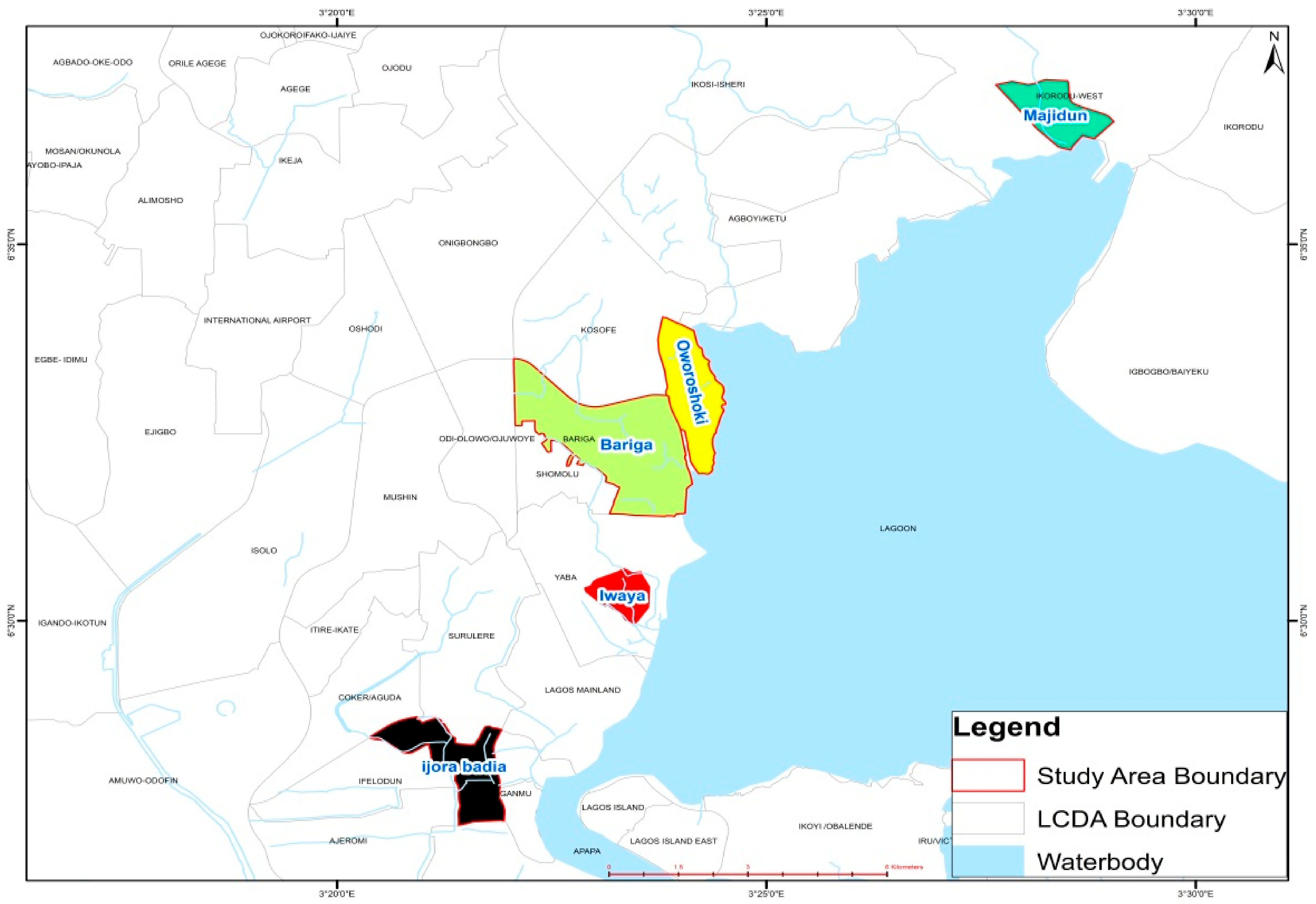
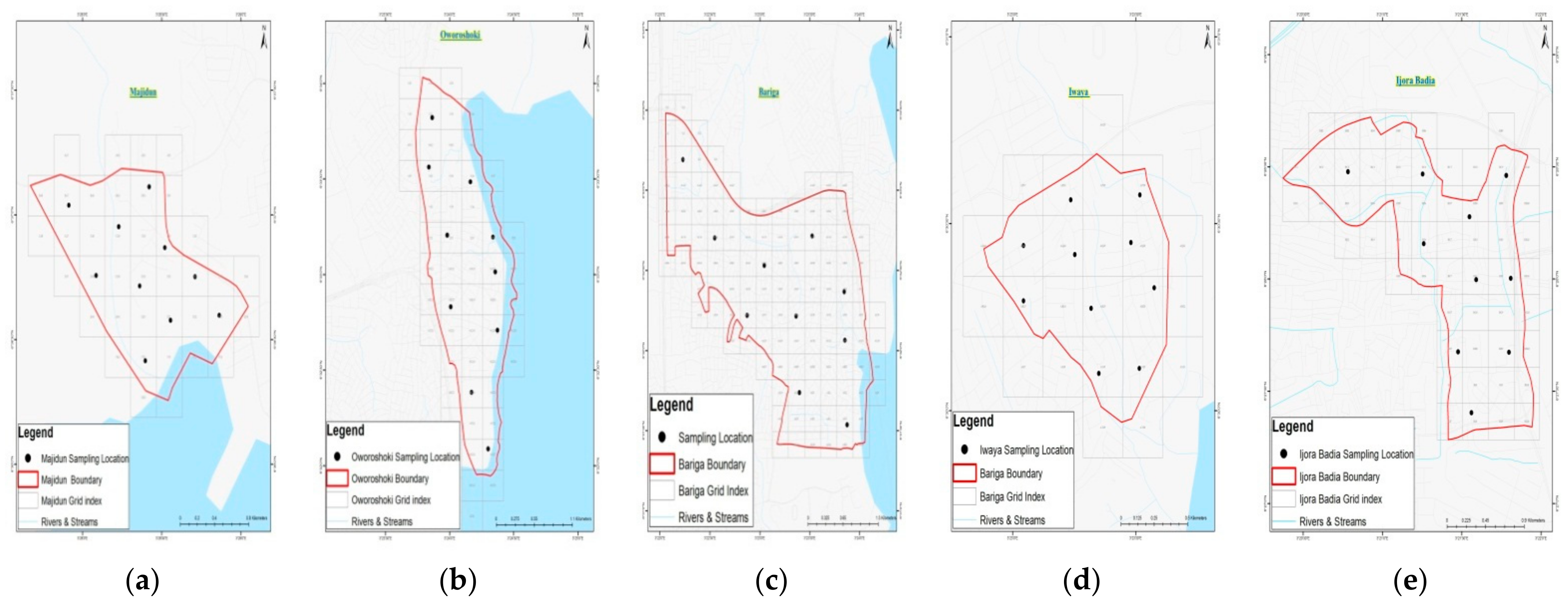
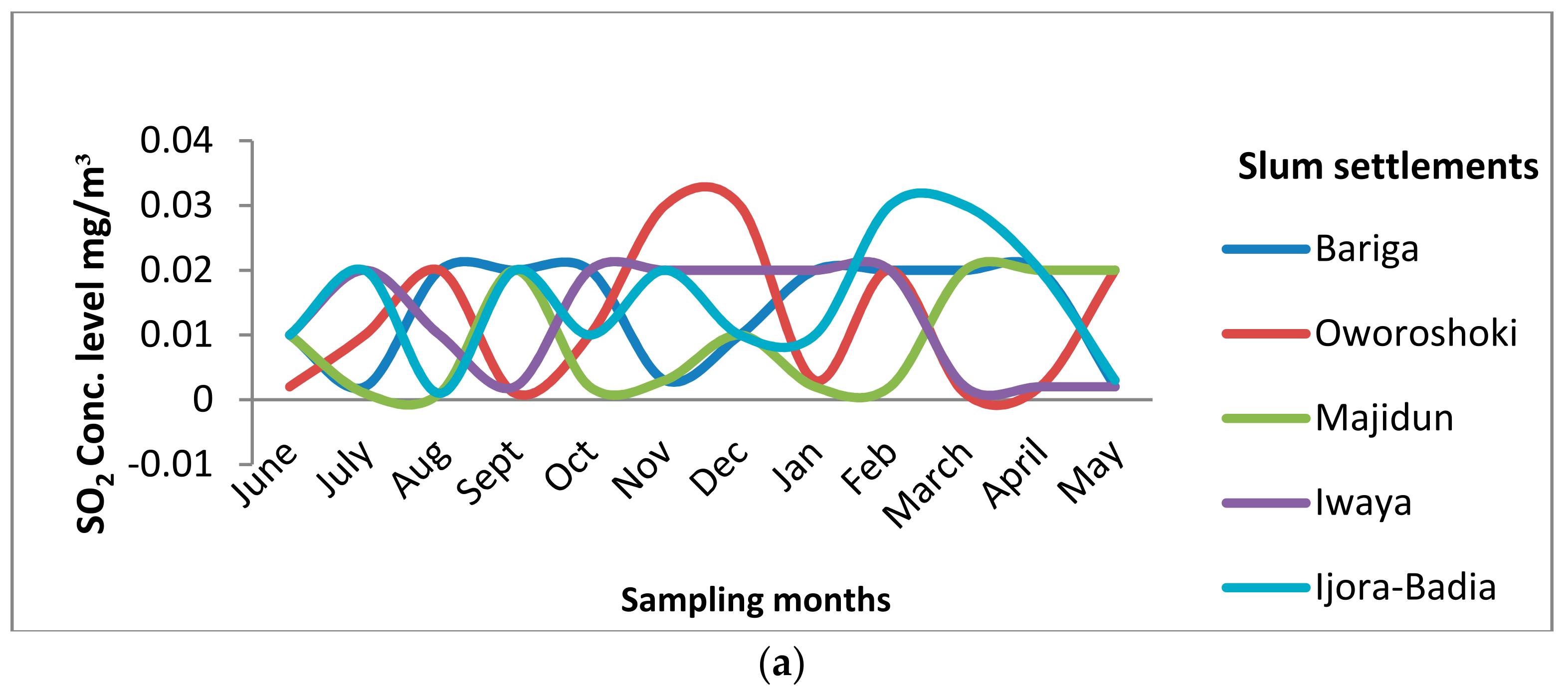
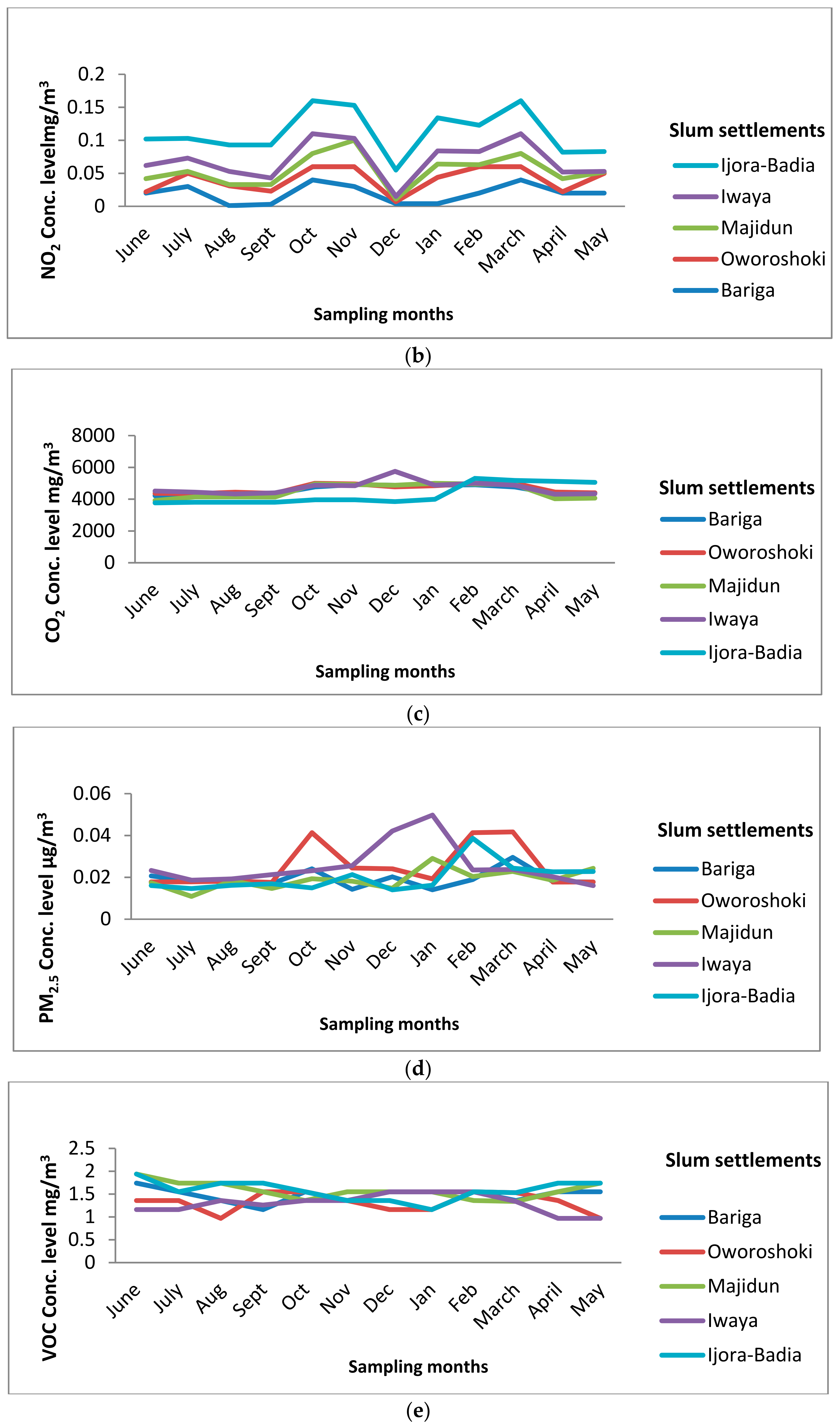
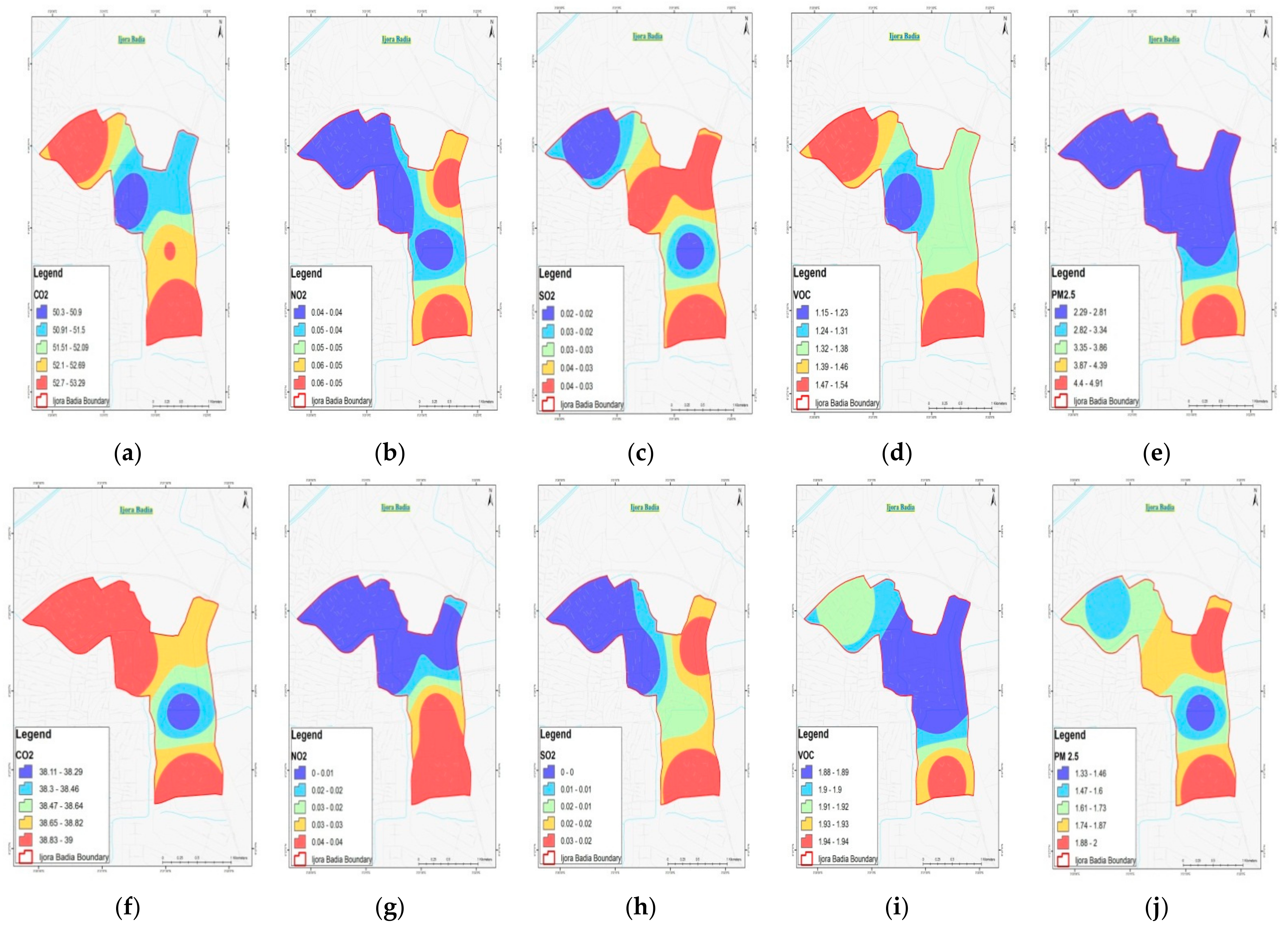
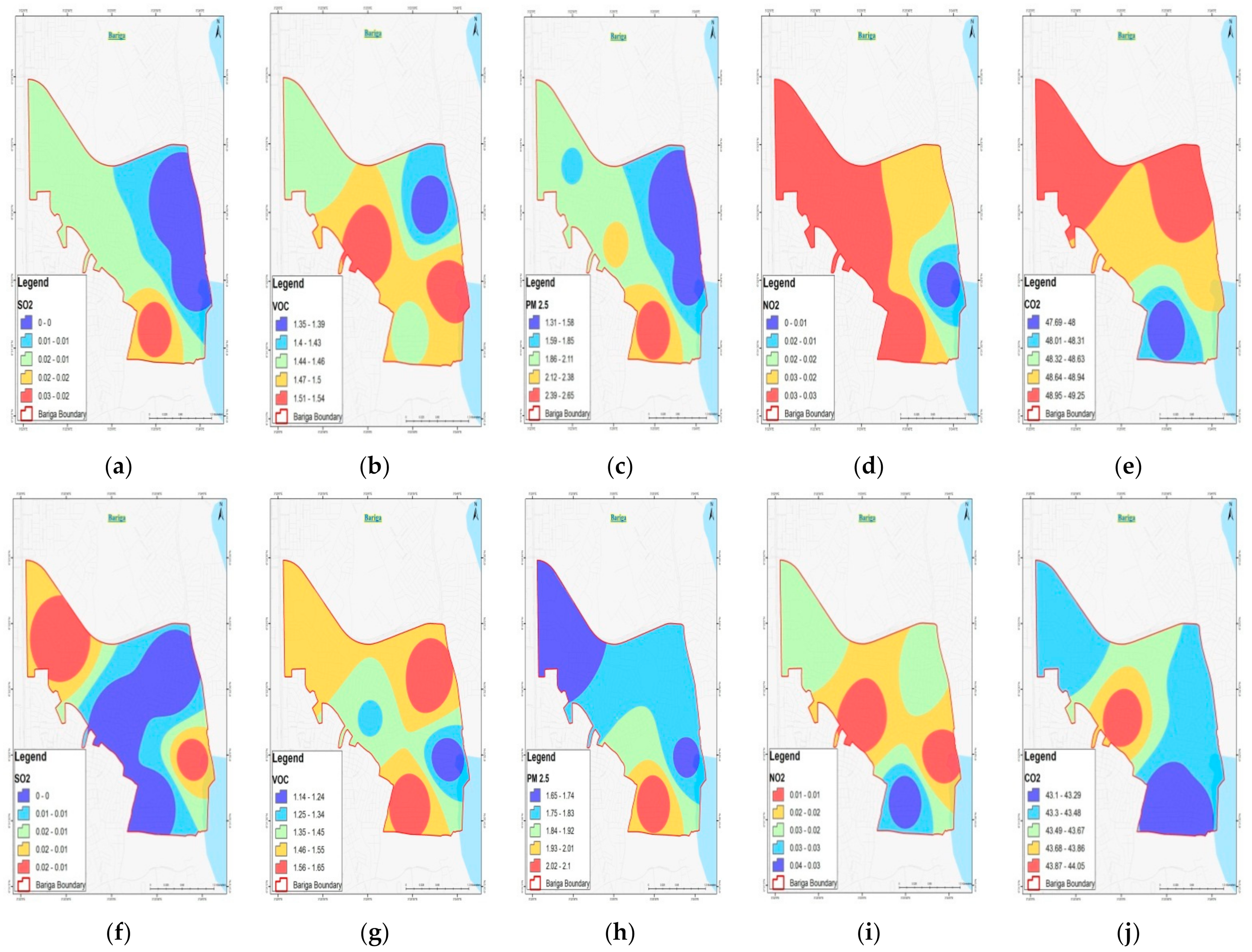
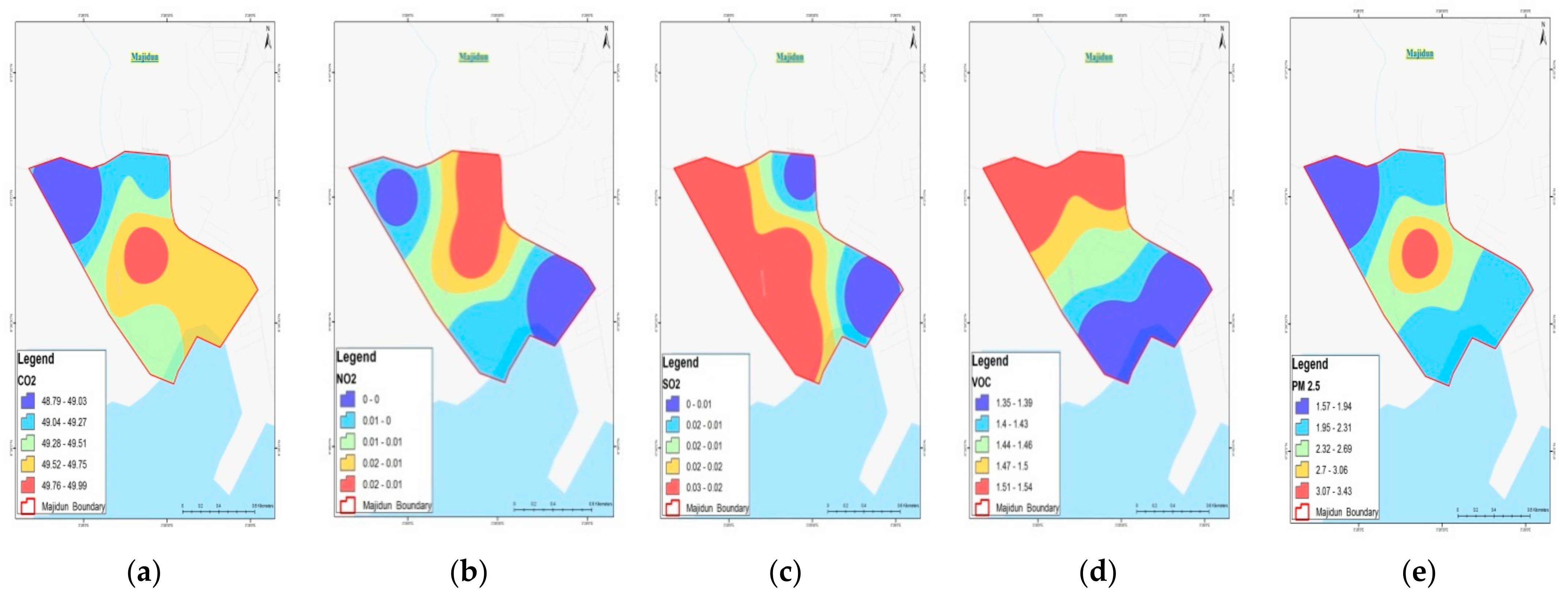
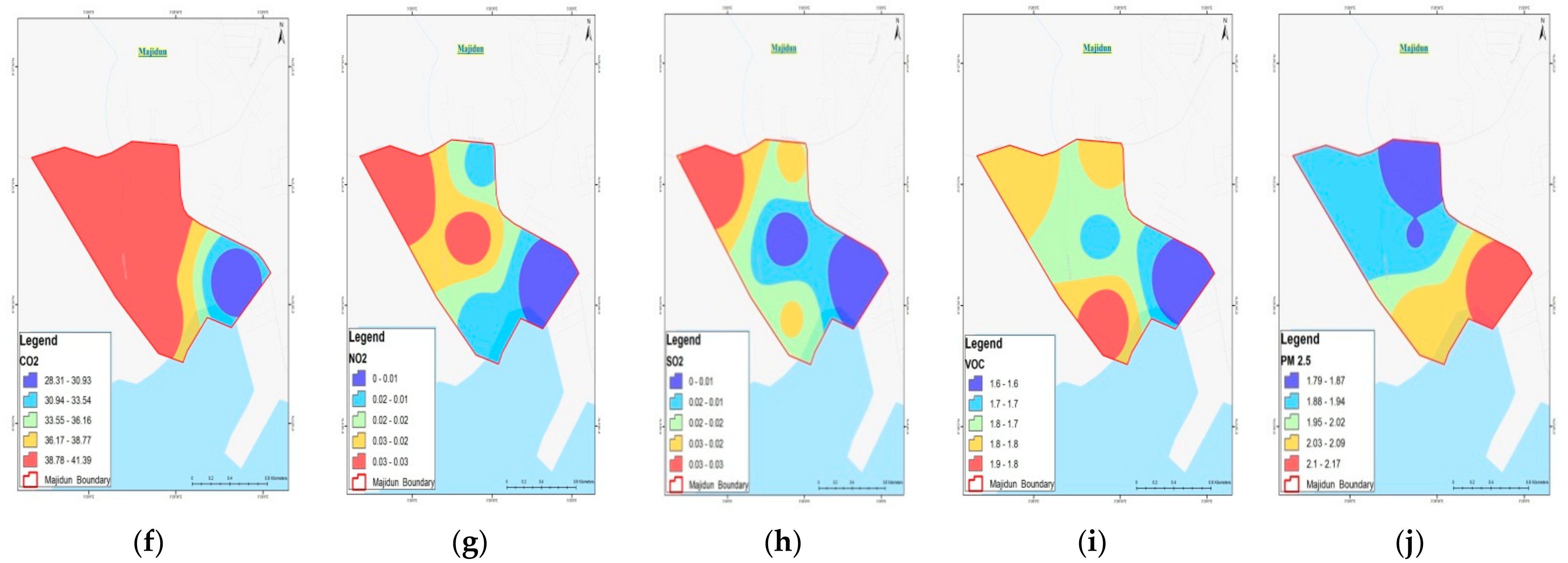
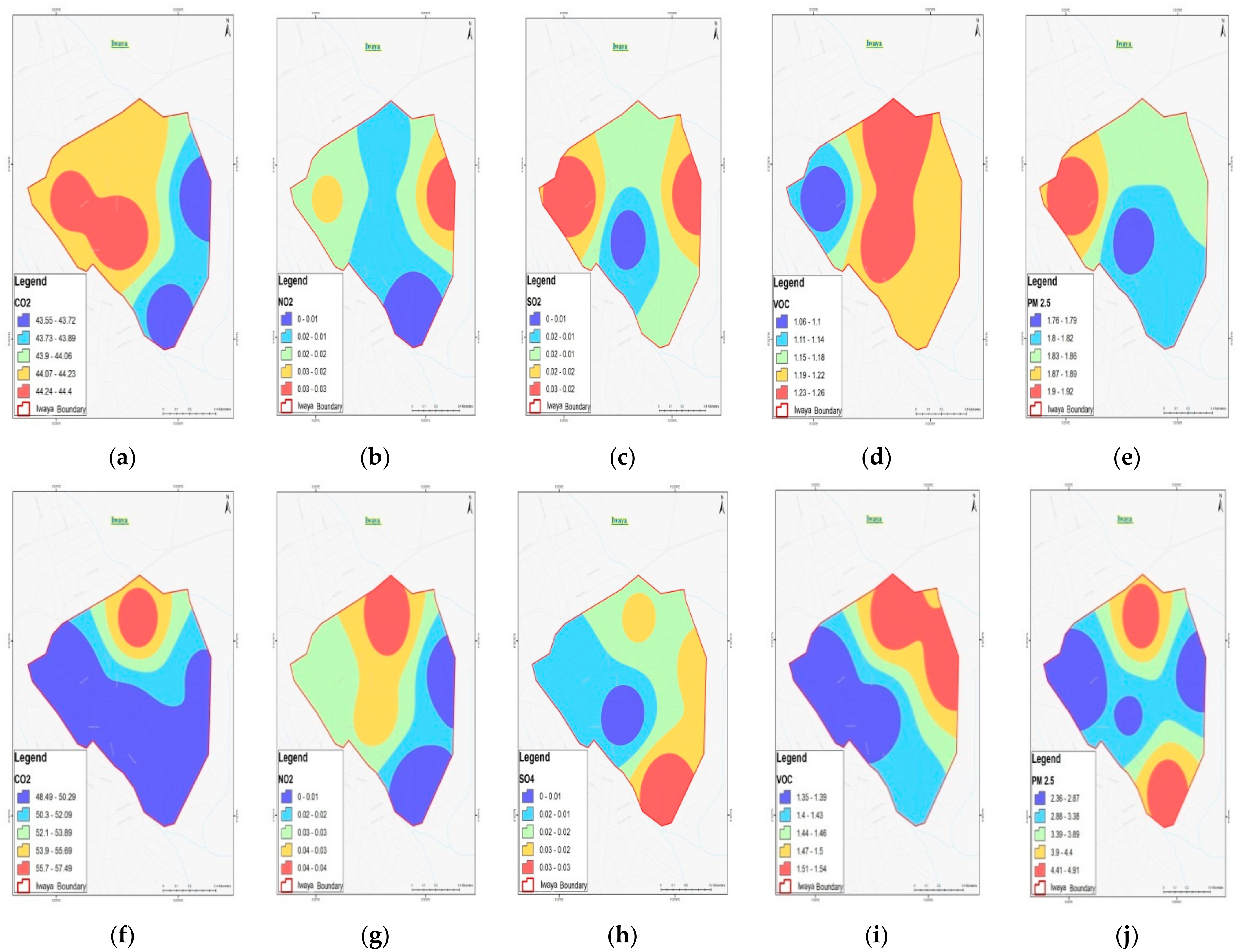

| Wet Season | ||||||||
|---|---|---|---|---|---|---|---|---|
| Code/N = 50 | Location | VOC mg/m3 | NO2 mg/m3 | CO2 mg/m3 | PM2.5 µg/m3 | SO2 mg/m3 | F-Tab | Sig. Level (p < 0.005) |
| SA | Ijora-Badia | 1.898 ± 0.026 d | 0.017 ± 0.020 a | 3875.60 ± 38.837 a | 1.734 ± 0.290 a | 0.010 ± 0.009 a | 25.476 | 0.000 |
| SB | Bariga | 1.454 ± 0.221 b | 0.018 ± 0.008 a | 4344.20 ± 36.204 b | 1.820 ± 0.176 a | 0.005 ± 0.004 a | 0.342 | 0.847 |
| SC | Majidun | 1.702 ± 0.110 c | 0.016 ± 0.013 a | 3843.00 ± 568.751 a | 1.956 ± 0.161 a | 0.015 ± 0.012 a | 6.143 | 0.002 |
| SD | Iwaya | 1.192 ± 0.081 a | 0.014 ± 0.010 a | 4400.40 ± 39.029 b | 1.834 ± 0.572 a | 0.013 ± 0.007 a | 1.482 | 0.245 |
| SE | Oworoshoki | 1.256 ± 1.136 a | 0.024 ± 0.014 a | 4384.40 ± 27.970 b | 1.956 ± 0.984 a | 0.010 ± 0.006 a | 0.935 | 0.464 |
| Dry Season | ||||||||
| Code/N = 50 | Location | VOC mg/m3 | NO2 mg/m3 | CO2 mg/m3 | PM2.5 µg/m3 | SO2 mg/m3 | F-Tab | Sig. Level (p < 0.005) |
| SA | Ijora-Badia | 1.386 ± 0.162 a | 0.044 ± 0.005 c | 5208.20 ± 138.401 b | 2.992 ± 1.079 ab | 0.026 ± 0.005 b | 0.680 | 0.614 |
| SB | Bariga | 1.466 ± 0.078 a | 0.022 ± 0.012 b | 4874.20 ± 62.651 a | 1.876 ± 0.553 a | 0.009 ± 0.008 a | 7.163 | 0.001 |
| SC | Majidun | 1.446 ± 0.095 a | 0.005 ± 0.004 a | 4941.40 ± 46.188 a | 2.258 ± 0.695 ab | 0.013 ± 0.009 ab | 2.562 | 0.070 |
| SD | Iwaya | 1.438 ± 0.096 a | 0.019 ± 0.016 ab | 5071.00 ± 383.367 ab | 3.348 ± 1.301 b | 0.016 ± 0.010 ab | 2.450 | 0.080 |
| SE | Oworoshoki | 1.346 ± 0.195 a | 0.030 ± 0.015 b | 4915.00 ± 102.127 a | 3.236 ± 0.936 b | 0.013 ± 0.012 ab | 2.414 | 0.083 |
| NAAQS (2012) Limits | - | 6000 (24 h) | 0.1 (1 h) | - | 3.5 (24 h) | 0.075 (1 h) | - | - |
| WHO (2006) Limits | - | 0.001–0.02 | 0.2 (1 h) | 5000X3 (TLV) | 2.5 (24 h) | 0.02 (24 h) | - | - |
| USEPA (2000) Limits | - | - | 0.05 (24 h) 0.04 (1 year) | - | 3.5 (1 h) 2.5 (1 year) | 0.2 (1 h) 0.125 (24 h) | - | - |
| Parameters | VOC mg/m3 (w) | CO2 mg/m3 | NO2 mg/m3 | SO2 mg/m3 | PM2.5 µg/m3 | Temperature °C | Atmospheric Pressure mm/Hg | Relative Humidity % |
|---|---|---|---|---|---|---|---|---|
| VOC mg/m3 (w) | 1.00 | |||||||
| CO2 mg/m3 | −0.937 ** | 1.00 | ||||||
| NO2 mg/m3 | 0.77 | −0.572 | 1.00 | |||||
| SO2 mg/m3 | 0.907 * | −0.994 ** | 0.56 | 1.00 | ||||
| PM2.5 µg/m3 | −0.874 * | 0.785 | −0.925 * | −0.792 | 1.00 | |||
| Temperature °C | −0.779 | 0.797 | −0.799 | −0.835 * | 0.937 ** | 1.00 | ||
| Atmospheric Pressure mm/Hg | 0.243 | −0.109 | 0.557 | 0.102 | −0.323 | −0.357 | 1.00 | |
| Relative Humidity % | 0.444 | −0.524 | 0.599 | 0.601 | −0.755 | −0.904 * | 0.253 | 1.00 |
| Parameters | VOC mg/m3 (d) | CO2 mg/m3 | NO2 mg/m3 | SO2 mg/m3 | PM2.5 µg/m3 | Temperature °C | Atmospheric Pressure mm/Hg | Relative Humidity % |
|---|---|---|---|---|---|---|---|---|
| VOC mg/m3 (d) | 1.00 | |||||||
| CO2 mg/m3 | −0.532 | 1.00 | ||||||
| NO2 mg/m3 | 0.172 | 0.456 | 1.00 | |||||
| SO2 mg/m3 | 0.40 | 0.365 | 0.947 ** | 1.00 | ||||
| PM2.5 µg/m3 | −0.684 | 0.531 | −0.499 | −0.517 | 1.00 | |||
| Temperature °C | −0.753 | 0.702 | 0.425 | 0.141 | 0.235 | 1.00 | ||
| Atmospheric Pressure mm/Hg | −0.078 | 0.169 | −0.028 | 0.148 | 0.333 | −0.284 | 1.00 | |
| Relative Humidity % | −0.477 | 0.393 | −0.551 | −0.599 | 0.832 * | 0.208 | −0.192 | 1.00 |
| Model Parameters (Wet Season) | r2 (%) | St. Error of the Estimate | F. Value | Sig. Level |
|---|---|---|---|---|
| Yvoc = X(RH) | 92.6 | 0.480 | 50.126 | 0.002 |
| YCO2 = X(T) | 99.7 | 2.422 | 1475.385 | 0.000 |
| YNO2 = X(RH) | 78.3 | 0.013 | 14.395 | 0.019 |
| YSO2 = X(RH) | 89.2 | 0.001 | 33.154 | 0.005 |
| YPM2.5 = X(T + AP) | 100 | 0.042 | 5006.222 | 0.000 |
| Model Parameters (Dry Season) | r2 (%) | St. Error of the Estimate | F. Value | Sig. Level |
|---|---|---|---|---|
| Yvoc = X(AP) | 72.0 | 0.062 | 0.858 | 0.641 |
| YCO2 = X(AP) | 73.8 | 1.357 | 0.940 | 0.622 |
| YNO2 = X(T + AP) | 60.7 | 0.010 | 0.515 | 0.742 |
| YSO2 = X(AP) | 84.4 | 0.004 | 1.809 | 0.489 |
| YPM2.5 = X(AP + RH) | 98.4 | 0.182 | 20.610 | 0.160 |
Publisher’s Note: MDPI stays neutral with regard to jurisdictional claims in published maps and institutional affiliations. |
© 2021 by the authors. Licensee MDPI, Basel, Switzerland. This article is an open access article distributed under the terms and conditions of the Creative Commons Attribution (CC BY) license (https://creativecommons.org/licenses/by/4.0/).
Share and Cite
Okimiji, O.P.; Techato, K.; Simon, J.N.; Tope-Ajayi, O.O.; Okafor, A.T.; Aborisade, M.A.; Phoungthong, K. Spatial Pattern of Air Pollutant Concentrations and Their Relationship with Meteorological Parameters in Coastal Slum Settlements of Lagos, Southwestern Nigeria. Atmosphere 2021, 12, 1426. https://doi.org/10.3390/atmos12111426
Okimiji OP, Techato K, Simon JN, Tope-Ajayi OO, Okafor AT, Aborisade MA, Phoungthong K. Spatial Pattern of Air Pollutant Concentrations and Their Relationship with Meteorological Parameters in Coastal Slum Settlements of Lagos, Southwestern Nigeria. Atmosphere. 2021; 12(11):1426. https://doi.org/10.3390/atmos12111426
Chicago/Turabian StyleOkimiji, Oluwaseun Princess, Kuaanan Techato, John Nyandansobi Simon, Opeyemi Oluwaseun Tope-Ajayi, Angela Tochukwu Okafor, Moses Akintayo Aborisade, and Khamphe Phoungthong. 2021. "Spatial Pattern of Air Pollutant Concentrations and Their Relationship with Meteorological Parameters in Coastal Slum Settlements of Lagos, Southwestern Nigeria" Atmosphere 12, no. 11: 1426. https://doi.org/10.3390/atmos12111426
APA StyleOkimiji, O. P., Techato, K., Simon, J. N., Tope-Ajayi, O. O., Okafor, A. T., Aborisade, M. A., & Phoungthong, K. (2021). Spatial Pattern of Air Pollutant Concentrations and Their Relationship with Meteorological Parameters in Coastal Slum Settlements of Lagos, Southwestern Nigeria. Atmosphere, 12(11), 1426. https://doi.org/10.3390/atmos12111426








